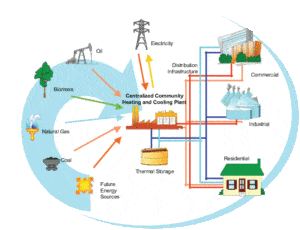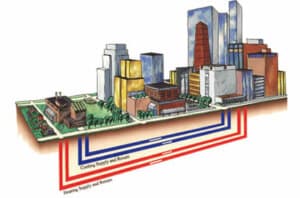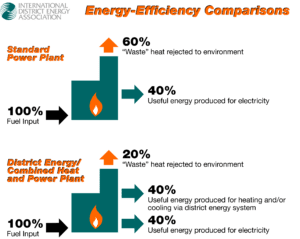The Issue
As the UK prepares to exit the European Union, District Heating systems are the perfect choice to reduce fuel imports.
The oil crises of 1973 and 1979 sent the price of oil soaring. Prices quadrupled and countries that were dependent upon imported oil suffered. Britain felt secure with its supply of North Sea oil and gas and unlike other countries, concentrated on improving its gas grid. As predicted, those supplies are running out fast and Britain is becoming increasingly reliant upon imported gas. As the UK prepares to leave the EU, now is the time to improve our energy security. District Heating Systems are a sustainable solution.
What District Heating has to offer
“District Heating and Cooling is the proven way to ensure that waste heat is recycled to provide comfort and domestic warm water to buildings, or even to cover certain industrial heat demands – thereby not only preventing unnecessary and unsustainable waste but also reducing the need for fossil fuels”
Euro Heat and Power Association
✓ Efficiency – Waste heat is captured and re-used, delivered direct to homes and businesses.
✓ Flexibility – A range of energy sources: renewable, non-renewable and combined.
✓ Environmentally friendly – Renewable energy is used and waste energy is recycled.
✓ Cost effective – One boiler instead of many, less installation, maintenance and monitoring.
✓ Reliability – 24/7 energy, every day of the year, not reliant upon one fuel source.
Why District Heating is the way forward
In their 2013 report, engineers Buro Happold discovered that in London alone over 70% of the city’s heating could be provided by the heat it wastes. Research published in Nature in March this year discovered that carbon release due to human activity reached a record high of ~10 Pg, the release rate of carbon reached the highest peak in 66 million years.
A system that captures and redistributes wasted heat will lower carbon emissions, reduce fuel consumption, eliminate waste and save money. The Department for Environment and Climate Change (DECC) are keen to see a significant increase in the use of District Heating networks. The DECC aim to increase the amount of properties connected to a District Heating network from 2% to 40% by 2050. To facilitate this increase they have made £7m available to councils to enable them to assess feasibility and begin implementation of District Heating.
What is a District Heating System?

How a District Heating system works

Image courtesy of International District Energy Association http://districtenergy.org/
A localised energy centre provides heat or chilled water to a network of end users: residential, commercial or industrial. Each energy centre contains a boiler that is large enough to provide energy for many homes and businesses. The boiler can be compatible with any fuel source. It could use non-renewable fuels such as coal, oil and gas as well as renewable fuels such as geothermal, solar, hydro, biomass and energy from waste. District Heating Systems capture waste heat and redistribute it, minimising wasted energy. Added to this, surplus heat is channelled back into the network by power stations, buildings, industries and transport networks throughout the network. Once it has provided energy to the consumer, the water within the pipe network returns to the energy centre to be re-used. The system is designed to reduce carbon emissions, eliminate waste, reduce fuel consumption and thereby cut costs.
Cogeneration uses Combined Heat and Power (CHP) in conjunction with a boiler. This is the production of electricity and heat simultaneously. In cogeneration plants, the heat energy that would normally be wasted during the burning of fuel is utilised to produce electricity. This makes the plant highly efficient; currently cogeneration is the most efficient form of power generation.
Where district energy can be used
Currently in the UK, district energy networks have been installed in towns and cities including: Sheffield, Nottingham, Southampton and Lerwick. Pre-insulated pipes deliver energy in the form of heated water or steam over many kilometres with very little loss of energy. Networks vary in size, some supplying energy to homes and flats within hundreds of meters, some supplying whole communities and industrial areas spanning several kilometres. This distance and the number of end users can be increased by adding more energy centres or increasing boiler size.
In the example of the Sheffield District Heating system, 43km of pipeline span the city centre. The city’s waste is incinerated providing energy to over 140 buildings including City Hall, Lyceum Theatre, the universities, Weston Park Hospital and the Millennium Galleries. Apart from the cost benefit, this prevents on average 21,000 tonnes of carbon dioxide into the environment.
The benefits of District Heating Systems
District Heating systems have myriad environmental and socio-economic benefits:
- Efficiency – Energy arrives at each building ready to use.
Heat loss from the pre-insulated underground pipes is minimal, approximately 1°C per km. Traditional power stations transmit electricity over hundreds of miles; much of this is lost along the way. District Heating is localised therefore distances and losses are greatly reduced.
An advanced energy centre using CHP can be as efficient as 80% compared to around 30% in a traditional power station.
The production of heat in one large central boiler is more efficient than multiple small boilers in many properties. - Convenience – Consumers don’t have the inconvenience of maintaining and monitoring their own boiler. End users have the convenience of a constant and reliable supply of heat, hot water and cooling all year round, on demand.
- Ease of use – End users control their own heat simply via a Heat Interface Unit (HIU) in their building.
- Cost – One central boiler to be maintained and monitored is shared between multiple users within the network. Users are saved the capital outlay as well as the maintenance costs. Because a wide range of fuels can be used, fuels can be chosen according to market costs at the time so the system running costs will always be competitive. The use of waste as a fuel reduces costs for the end user. Reduced initial outlay for end users including construction companies with no need to buy individual boilers within each property. Additionally, the rate for wholesale gas is cheaper than the rate for domestic gas.
- Flexibility – A wide variety of users can benefit. The combination of a range of energy generation technologies ensures demand can be met.
- Environmentally friendly – A more efficient system of energy generation combined with the incineration of waste and capture and re-use of waste heat significantly reduces CO2 emissions and lowers the carbon footprint. The use of renewable energy sources extends their potential and viability. Industry experts recommend the use of CHP within District Heating as the cheapest way to cut carbon.
- Incineration of waste – Waste that is non-recyclable can be incinerated instead of going to landfill; the heat produced is turned to useful energy.
- Reliability – With the ability of utilising a variety of fuel sources, a supply of fuel is guaranteed.
- Life cycle costs – Only one central boiler to be purchased, monitored and maintained instead of many.
- Increased space – As no boiler or air conditioning unit is needed, additional space is created within each building that can be utilised in more beneficial ways. This offers greater flexibility of design.
- Security of supply – Use of a greater range of fuel sources secures supply and the ability to meet demand.
- Safety – The energy centre is located separately to the network and closely monitored. One boiler installed, maintained and monitored under strict conditions leaving every building within the network boiler free. The safety issues associated with boilers are thus removed from every building and user in the network.
- Economy of scale – The increased level of production is reflected in a decrease in costs.
- Less dependent upon energy imports from other countries
How do they compare to traditional heating systems?
Favourably! As we have seen in this article, District Heating Systems are more energy efficient, being able to utilise waste heat and deliver ready to use energy ‘on demand’ to consumers. Significantly less energy is lost during transmission to the buildings in the network compared to the transmission of energy along hundreds of miles of cable. Another major difference is the use of only one central boiler instead of a boiler in each location.
The diagram below illustrates standard power plants producing around 40% of useful energy and wasting the remaining 60%. This is compared to around 80% useful energy from a District Heating System with CHP, only 20% is wasted.

Illustration courtesy of International District Energy Association
<h2″>Temporary boiler hire for District Heating Systems
In the unlikely event of boiler breakdown, the response needs to be fast and effective. Ideal Heat Solutions recommend our high capacity 1120kw packaged boiler system which is easily able to cope with the demands of a District Heating System. We are SafeContractor accredited and are fully insured. We have been providing state-of-the-art temporary boilers as part of planned or emergency work to businesses and industries in London and the South East for 15 years. We can be on site within two hours and our OFTEC-approved Climate Solution engineers will provide advice and the right solution for your particular needs. The boilers that we install come complete with Trend 963 Supervisor Monitoring System, we are able to monitor and control our boiler remotely giving you the peace of mind of knowing it is taken care of.